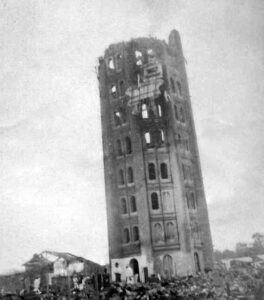
 It was a typical lunch hour in Japan’s capital city of Tokyo, and the neighboring “City of Silk” Yokohama that September 1, 1923. People were out and about doing their normal lunchtime things, eating and running errands before going back to work. Suddenly the days routine was shattered when a massive, 7.9-magnitude earthquake struck just before noon. The shaking lasted just 14 seconds, but that was all it took to bring down nearly every building in Yokohama, which is just south of Tokyo. The shaking also caused more than half of Tokyo’s brick buildings, most of Yokohama’s buildings, and hundreds of thousands of homes to collapse, killing tens of thousands of people instantly.
It was a typical lunch hour in Japan’s capital city of Tokyo, and the neighboring “City of Silk” Yokohama that September 1, 1923. People were out and about doing their normal lunchtime things, eating and running errands before going back to work. Suddenly the days routine was shattered when a massive, 7.9-magnitude earthquake struck just before noon. The shaking lasted just 14 seconds, but that was all it took to bring down nearly every building in Yokohama, which is just south of Tokyo. The shaking also caused more than half of Tokyo’s brick buildings, most of Yokohama’s buildings, and hundreds of thousands of homes to collapse, killing tens of thousands of people instantly.
Known as the Great Kanto Earthquake, but also called the Tokyo-Yokohama Earthquake, of 1923, it caused an estimated death toll of more than 140,000 and left some 1.5 million people homeless, according to reported numbers. Following the earthquake came another disaster in the form of fires that burned many buildings. Most likely, this was because in 1923, people cooked over an open flame, and the quake struck while people were preparing lunch. To further complicate matters, the area was hit by high winds, caused by a typhoon that passed off the coast of the Noto Peninsula in northern Japan, spread the flames and created horrifying firestorms. Because the quake had snapped water mains, the fires could not be extinguished until September 3rd. By that time, about 45 percent of Tokyo had burned. Some researchers believed that the typhoon may have triggered the earthquake, because the forced atmospheric pressure pressed on a stressed and delicate fault line of three major tectonic plates that meet under Tokyo. I wasn’t aware that this was possible, but  apparently it is. The quake also triggered a tsunami that swelled to 39.5 feet at Atami on the Sagami Gulf, where 60 people were killed and 155 homes destroyed.
apparently it is. The quake also triggered a tsunami that swelled to 39.5 feet at Atami on the Sagami Gulf, where 60 people were killed and 155 homes destroyed.
The damage from all this in Toyko was so severe that some government leaders argued for moving the Japanese capital to a new city. Educator, Miura Tosaku toured the destruction of Tokyo in the fall of 1923, concluded that the earthquake was an apocalyptic revelation. He wrote: “Disasters take away the falsehood and ostentation of human life and conspicuously expose the strengths and weaknesses of human society.” Tenrikyo relief worker Haruno Ki’ichi said, “The destruction and devastation in the earthquake aftermath surpassed imagination.”
Yokohama’s Victorian-era Grand Hotel, that had hosted famous people including US President William Howard Taft and English author Rudyard Kipling, completely collapsed. Hundreds of hotel employees and guests were crushed. Henry W Kinney, a Tokyo-based editor of the Trans-Pacific publication, observed the devastation in Yokohama hours after the earthquake hit. He wrote, “Yokohama, the city of almost half a million souls, had become a vast plain of fire, of red, devouring sheets of flame which played and flickered. Here and there a remnant of a building, a few shattered walls, stood up like rocks above the expanse of flame, unrecognizable … It was as if the very Earth were now burning. It presented exactly the aspect of a gigantic Christmas pudding over which the spirits were blazing, devouring nothing. For the city was gone.”
Since 1960, the Japanese people recognize the September 1 anniversary of the earthquake as Disaster Prevention Day. It’s a noble idea, but I’m not sure how these disasters could be prevented, other than the now common practice of earthquake proofing buildings to prevent so much loss. Nevertheless, Japan has suffered through several more devastating earthquakes. More than seven decades after the 1923 disaster, an earthquake struck Kobe on January 17, 1995. This Kobe Earthquake caused an estimated 6,400 deaths, widespread fires, and a landslide in Nishinomiya. Then, on March 11, 2011, a 9.0-magnitude temblor struck off th
 e coast of Japan’s city of Sendai. This Tohoku Earthquake and Tsunami caused a series of catastrophic tsunamis in Japan, and more than 18,000 estimated deaths. I suppose that to say the very least, the loss of life in these more recent quakes, was far less than in the original event that founded Disaster Prevent Day.
e coast of Japan’s city of Sendai. This Tohoku Earthquake and Tsunami caused a series of catastrophic tsunamis in Japan, and more than 18,000 estimated deaths. I suppose that to say the very least, the loss of life in these more recent quakes, was far less than in the original event that founded Disaster Prevent Day.


Leave a Reply